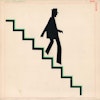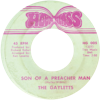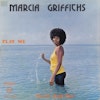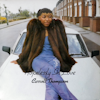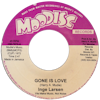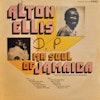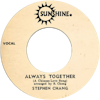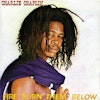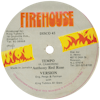These were the early beginnings of the contemporary dancehall style, which was brought to prominence outside of Jamaica by Greensleeves Records. The most important and best-admired vocalist to emerge from the early dancehall movement was Barrington Levy, a cool crooner who sang of hardship, enjoyment, strife, and delight in equal measure, his high tenor lyrics punctuated by trademark, elongated vowels stretched over several measures, an extended exhortation of “Whoah-oh-oh.” As Greensleeves celebrated their official thirtieth anniversary in 2007, Barrington Levy—their first significant artist to break through with the dancehall style—remains paramount with his innovative approach to singing and songwriting.
Meeting the man face-to-face just after an appearance on the morning talk-show program on TVJ, Jamaica’s leading terrestrial television station, Levy seems a humble man, eminently approachable and down to earth. He begins the interview by explaining that music has always been a central part of his life.
“I grew up in the Kingston 11 area, and then, when I was, like, eight years old, I left and I go to country, which is in the Clarendon area, and that’s where I start to pursue my singing career. The difference is the quietness of the country[side] and the excitement of Kingston: the quietness of country really give me the energy to sit down and put lyrics together, and then the excitement of Kingston help to boost me to look out there and do it. I couldn’t tell you how it happened, but music is everything from day one, so I really put my everything into it and decided that I want to be a singer. I was inspired by Michael Jackson, because I see Michael Jackson on television, and that really bring a buzz as a young kid, tearing up the place. Dennis Brown is my favorite [Jamaican] artist who uplift me—same way with John Holt. In those days, I didn’t write lyrics, I didn’t put pen to paper; I get an idea within my head and improve on it until I say, “Yes, this is a great idea, I’m going to put it on tape.’ ”
After returning to western Kingston in his teens, Barrington formed a little-known vocal group with a cousin. “This is when I leave from Clarendon and come back to Kingston,” he recalls. “I was, like, thirteen years old. We do two songs together as the Mighty Multitudes. I was still going to school, but I still have time to do my thing. School was all right, but I was more focused on getting my songs on the radio; my main interest was there.”
The group’s first single, “My Black Girl,” was recorded after Ansel Cridland, leader of local harmony trio the Meditations, introduced the pair to singer-turned-producer Dobby Dobson, who was then holding auditions at Federal recording studio. A second single, “Been a Long Time,” was produced by singer/arranger Barry Biggs for Dynamic Sounds, but neither single made much impact. As Barrington explains, “The Meditations are from Majesty Gardens. They used to sit on the gully bank and play their guitar, and, as a kid, I used to just stand by and watch them. I was living in that area, then I get a chance to go up to Ansel and said, ‘I can sing, you know. I have a song.’ He said, ‘Sing it, make I hear it.’ And I sing it, and he strum the guitar. Then I just link up with my cousin, and we just go to the studio, and we voice the song. Then maybe two years after, one of the musicians from the Dobby Dobson session introduced me to Barry Biggs and say, ‘This youth can sing, you know.’ So we did the song for Dynamic Sounds, but after that, it was struggling again. Nothing much happened with those tracks, so me and my cousin started to argue about money, and we split. So I take to the dance hall, the sound system, as a solo act, and that’s where it started. There was a sound called Burning Spear, and there was a sound called Tape Tone—they were based in Kingston 11 at Payne Avenue. I just went round the mic one night—Leroy Smart was singing on the sound, and I went round there—and Junior Brammer, which is Trinity, said, ‘Come here, youth! You can sing,’ and just give me the mic. I sing the first tune called ‘Shine Eyed Girl’ and another called ‘Collie Weed,’ and that place was going crazy!”
Barrington was one of a handful of singers active on sound systems in this period, and his unique vocal approach gave him an edge over many of his peers. Once Barrington hooked up with political “enforcer” turned record producer Henry “Junjo” Lawes, dancehall entered a whole new dimension: Junjo had been working at Channel One studio with the Roots Radics, a hot set of backing musicians that spun off from the remnants of the Morwells group; about two dozen of their fresh rhythms were voiced by Barrington at King Tubby’s legendary studio in Waterhouse, the results being particularly memorable. Material from this first set of sessions not only made Barrington a household name in Jamaica through his first number one hit, “Collie Weed,” but also yielded classic, adventurous albums issued on grassroots reggae concerns both at home and abroad, such as Bounty Hunter, issued in the U.S. on the Jah Life label; Shaolin Temple, which was released in Jamaica on Junjo’s Jah Guidance imprint; and Shine Eye Gal, issued in the U.K. on Burning Sounds.
My intention was to keep it cultural, keep it dance, keep it lover’s rock, make a mixture of bothBarrington Levy

As Barrington explains, “Sugar Minott used to sing on sound system, but he already go to Studio One and start making songs; you have Barry Brown and Tristan Palmer, but I just went ahead and just do my thing. One day, I went to a talent show, and Junjo Lawes send somebody to say Junjo would like to see me. So I went to see Junjo, and he’s saying he has a track that he would like me to go on. I went to the studio and did a song called ‘A Yah We Deh,’ giving thanks and praise, and then I did ‘Collie Weed,’ and ‘Collie Weed’ becomes huge in Jamaica. When he approached me, he wasn’t really established as a producer; he was a new guy on the block. I didn’t know who he was, but I didn’t care who he was; I was just interested in getting my song on the street. I used to walk to the established studios like Joe Gibbs, and they used to give me the runaround, like, ‘Come back next week.’ But Junjo showed interest and believed in me, so that’s when I went with him. When ‘Collie Weed’ bust, my head swell big, huge, and I was so happy. Then I made an album called Shaolin Temple, and they released a different version of it in America called Bounty Hunter.”
The albums formed stepping stones to Barrington’s eventual stardom, but it took the concerted efforts of Greensleeves in the U.K. and the strong links they had with the U.S.-based distributor Shanachie to really raise the singer’s international profile. “When that voice came, it was like a whole new era had started in Jamaica,” says Chris Cracknell, the longstanding head of Greensleeves A&R, who has been involved with the company from its early incarnation as a west London record shop. “People wanted that new sound, that new flavor. Times were changing in Jamaica, and there was a change in producers as well. Just before Junjo came, we were in the days of Island Records putting out Black Uhuru with Sly and Robbie, but because Black Uhuru got so popular, Sly and Robbie were off the island touring. There was this void in Jamaica, and Junjo filled that void, and it was a revelation. Shine Eye Girl from Barrington Levy, we just could not get enough copies. We could not keep that Bounty Hunter album in stock; it came in, and literally everybody bought it—thousands of copies. It was just unbelievable.
Because we built up a good reputation for licensing, treating people well in Jamaica, we started to get a number of Jamaican producers coming to see us. I remember the first time Junjo turned up at our store one evening to introduce himself, and we were like, ‘Oh, Barrington Levy, Bounty Hunter.’ And he said, ‘No, I’m afraid you can’t have that album; I’ve already licensed it.’ But he had some other things with him that hadn’t been licensed, so we said to him, ‘We don’t really want the leftovers, but on your next trip up here, make sure we’re the first stop. Do a Barrington Levy album, because we’re definitely very interested.’ So on his next trip up, he’d done the Englishman album. That’s how that whole thing kicked off.”
Nineteen seventy-nine’s Englishman and its predecessors made a huge impact outside Jamaica, because Barrington’s vocal style was unique—his upfront delivery and clever lyrics struck a chord with music fans all over the world. “What I was doing different, I don’t know, because my intentions was the same as when I was with the group: my intention was to keep it cultural, keep it dance, keep it lover’s rock, make a mixture of both,” he explains. “And when I just started to smoke weed, I get all these vibes from it. Like, if I burn a spliff and I sit down, I’ll be hearing a lot of sounds, and I just picked a sound, something that was different from everybody’s sound. Although Michael Jackson was my favorite artist, and Dennis Brown, I still try to come with my own style. It’s all about being different: I don’t like to follow trends; I set trends.”
In addition to Barrington’s outstanding vocal style, part of what made this music so great was the supreme musicianship of the Roots Radics, whose hard-edged backing often took the form of dancehall-oriented re-cuts of classic Studio One and Treasure Isle classics; their forward-facing backing tracks, captured in high fidelity stereo at Channel One, gave the songs a futuristic edge that helped propel the music ever forward. Such material was given its ultimate shape by the highly creative mixers at King Tubby’s legendary Waterhouse voicing and dub mixing facility, particularly by the young Hopeton “Scientist” Brown.
As has been well documented, Tubby was the electronics repair wizard and sound system operator who was instrumental in the development of dub as an art form; the great majority of work for Jamaica’s grassroots ghetto producers was voiced and mixed in his tiny front-room studio, first by the King himself and his first apprentice, Philip Smart, and later by Pat Kelly, Prince Jammy, Scientist, and, occasionally, by Professor and Peter Chemist. At the time of the Barrington Levy sessions, Prince Jammy and Scientist were the two mixers most commonly active at Tubby’s premises, and their dub mixes of Barrington’s material formed some of the last great “classical” dub works ever to surface from Jamaica, while Scientist’s skilled engineering shaped the overall feel of Barrington’s standard vocal output. “It was the same formula anyway,” Barrington emphasizes, “Englishman, Robin Hood, Bounty Hunter—it was strictly Scientist, same way.”
After the release of the Robin Hood album, Barrington drifted away from Junjo’s stable. But strong work would follow from other producers—the Poor Man Style album was assisted by Linval Thompson; and, for Money Move, the fearsome George Phang, a producer whose tenure in the music business proved ultimately brief and who was nearly fatally wounded by gunmen some years ago. “George Phang is a bad man from Jamaica,” Barrington explains. “I was trying to get him out of certain things, could make him be a producer, and he tried it and he was very successful. But after he find out that the part where he’s not getting his money properly, people putting out stuff on white label and are not accountable for it, he just said he can’t deal with it, ’cause he don’t want to hurt nobody. But he will always be a bad boy—nothing’s changed.”
Barrington also became frustrated with these kinds of business practices relating to the release of his material. In an effort to take better control of his own destiny, first he cut the Do Re Mi album—voiced at Channel One and King Tubby’s over alternate cuts of some of the earlier Radics rhythms voiced for Junjo—and then he migrated to England, where he was based between 1982 and 1992. “My first trip to England was ’79,” Barrington notes. “I went up to do the Black Echoes [radio program] awards show. Then I go to England to live for a while. When I was down here [in Jamaica], all I could see was just producers trying to rip you off; they’re not paying you. They go to foreign, and they sell your stuff to record company, and you don’t know nothing about it. I went to England for the main reason to learn about the music business, learn about publishing. England teach me a lot about the business aspect of it. It was great: that’s where I do my biggest hit records, like ‘Broader Than Broadway’ [aka ‘Here I Come’], ‘Under Mi Sensi,’ ‘Too Experienced,’ ‘My Time,’ ‘Living Dangerously.’ The majority of those songs were made in England.”
Amazingly, “Under Mi Sensi” set the blueprint for Wayne Smith’s “Under Mi Sleng Teng,” the song that kicked off Jamaica’s digital revolution. Yet Barrington is not bitter, despite the lack of recognition for his earlier hit. As he explains, “ ‘Sleng Teng’ was a copy from ‘Under Mi Sensi.’ ’Cause when they come to England and hear the song, Jammys come back down and do ‘Under Mi Sleng Teng,’ but it’s really the same thing they’re really talking about, copycat. I didn’t care; I just feel good within myself to know that they admire my style so much that they would come down and do something like that. The thing is, they don’t give me no credit, but I know the truth, and even you know the truth.”
Barrington says that the massive hit “Here I Come”—a tale of an irresponsible young mother, broken up by the recurrent chant “I’m broad, I’m broad, I’m broader than Broadway”—was inspired by something that actually happened. “It’s a personal experience, but not with me,” he laughs. “It’s something that happen to one of my friends where the girl have a kid. She was young and get pregnant, and, after she had the kid, she was murmuring, saying she don’t want to stay inside and look after no kid, because she have to have fun, because she’s young. She take the kid and leave it with her mom, and she did go out [at night time], only to find out that that’s not how to live life. Her kid was very important, so she end up going back home and get her kid. The relationship, they split up, but she see that her kid need her.”
Despite the successes he found with such material during his years of living in Britain and the U.S., Barrington says he is happy to have returned to the tranquility of rural Clarendon some years ago. “Foreign is very stressful,” he emphasizes. “I mean, it’s stressful here in Jamaica, but not as much as there. Because, if I’m in Jamaica, I can produce my own food, but in foreign, I have to buy what they’re selling, and sometimes it’s not even healthy. They use chemicals; it’s just horrible.”
I’m more interested in writing, walking in the street, and getting new ideas for songwriting.Barrington Levy
In recent years, Barrington has been expanding his musical horizons with a few notable collaborations with artists from the rock and hip-hop worlds. “I did something with [Canadian rock group] Shine, which went well; working with Shine was very exciting, and [it got] the right promotion. I did something with the Rascals from Canada; they are nice people, and it was fun to work with them. I also did something with Snoop Dogg for my album, but, before that, there was a track I was working on with Snoop for Soopafly, and Daz Dillinger did something on that—that was from 1998. It didn’t come out, but when he come down here in 2001 for Sumfest, they was asking him who is his favorite reggae artist, and he mentioned me. He was saying, ‘Barrington Levy’s talented, and I want to do something with Barrington on my new album,’ and we did it, and he did something back for my album. Snoop is bad! I also did something with Shaggy.”
Barrington says he is happy to have reached a stage in his career when he can record and produce the music he wants to make on his own terms, taking several years to complete an album to his satisfaction, if necessary. “I love what I do, and I’m not in the music business to please the record company,” he says categorically. “I’m doing it because I love it. Back in the days, I was forced to, in a sense, do things, and some of the things that I do, I wasn’t happy with it, but I have to just live with it. Now I want to do an album that’s gonna make a lot of sense, that people can say, ‘Yes, this is a great album,’ and you cannot do it in a rush.”
In 1999, Barrington also diversified into music promotion; now, his annual “Dancehall Rock” event is one of the most greatly anticipated festivals to take place on the island. “It’s growing,” he says happily, “and the concept behind Dancehall Rock is: back down in the days where you go to a dance, you find a man who go to a lady and say, ‘Can I have a dance?’ But nowadays, it don’t happen any more; the girl is on that side, and the guy is on [the other] side, and they just look at each other. I don’t know why is that, but I think that Dancehall Rock is for to bring back that kind of vibes, where one can be not worried [to] take a lady, have a dance, and then the only thing they can think about is to go make love next, instead of standing up in the dance, not dancing, staring there, thinking, ‘Oh, there’s my enemy; let’s kill him.’ Back down in days in the dance, you don’t have no time to think about that; you’re either going to make love or you’re going to dance all night with a lady. So I just bring back in that.”
In addition to more great music from the man, Barrington says we can also expect to see him on the silver screen some time soon. “Acting, that’s what I want to do. I won’t say yet, but there’s a little thing going to be happening soon. But I don’t really go to the movies or read books much; I’m more interested in writing, walking in the street, and getting new ideas for songwriting.”
As the singer is obviously a busy man, I hit him with one last question before he makes his exit: if he never got involved in music, what would Barrington Levy be doing now? He thinks momentarily, before answering with a wry smile, “Maybe I’d be a mechanic; I don’t know, but I get a high mark at school for auto mechanics.” It seems the auto repair world’s loss is the music lover’s gain, as Barrington continues enthralling audiences all over the world, just as he did with his vinyl debut three decades ago.
